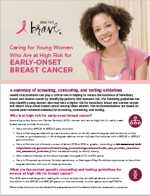Assessing Risk in Young Patients
Identifying Young Women With Increased Risk of Hereditary Breast and Ovarian Cancer
Health care providers can play a critical role in helping to reduce the incidence of hereditary breast and ovarian cancer by identifying patients with elevated risk. The following guidelines can help identify young women who may have a higher risk for hereditary breast and ovarian cancer and detect early-onset breast cancer among these women.
Who is at high risk for early-onset breast cancer?
According to the American Cancer Society (ACS), women who are at high risk for early-onset breast cancer include those who—
- Have a known BRCA1 or BRCA2 gene mutation.
- Have a first-degree relative* (parent, brother, sister, or child), second-degree relative (aunts, uncles, nieces, or grandparents), or third-degree relative, which includes first cousins, with a BRCA1 or BRCA2 gene mutation.
- Have a lifetime risk of breast cancer of about 20% to 25% or greater, according to risk assessment tools that are based mainly on family history.
- Had radiation therapy to the chest between the ages of 10 and 30 years.
- Have Li-Fraumeni syndrome, Cowden syndrome, or Bannayan-Riley-Ruvalcaba syndrome, or have first-degree relatives with one of these syndromes.
*Risk is higher with more than one affected first-degree relative and if the affected relative was diagnosed at a young age.
What are the current genetic counseling and testing guidelines for women at high risk for breast cancer?
The ACS recommends genetic testing for women at high risk, as defined above, to look for mutations in the BRCA1 and BRCA2 genes (or less commonly in other genes such as PTEN or TP53). Although testing can be helpful in some situations, providers need to weigh the pros and cons with the patient. The ACS strongly recommends that women first talk to a genetic counselor, nurse, or doctor who is qualified to explain and interpret the results of these tests.
The U.S. Preventive Services Task Force (USPSTF) recommends that women who have one or more family members with a known potentially harmful mutation in the BRCA1 or BRCA2 genes should be offered genetic counseling and testing. Women with an identified increased risk should be referred to a genetic counselor, who can further evaluate the risk based on family history, discuss the pros and cons of testing, and arrange for BRCA testing if the patient is ready to proceed.
- Page last reviewed: June 15, 2017
- Page last updated: June 15, 2017
- Content source:



 ShareCompartir
ShareCompartir
